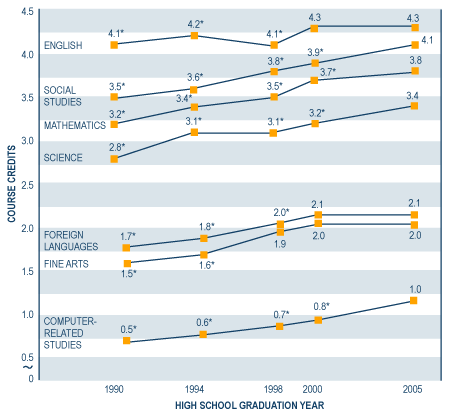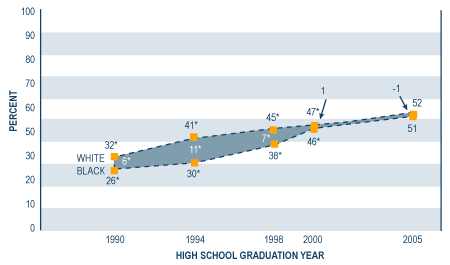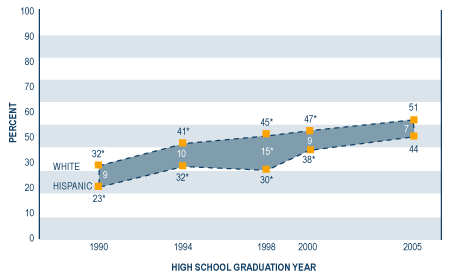High School Transcripts for the Class of 2005
This indicator presents information about the types of courses that graduates took during a 4-year high school curriculum and how many credits they earned in particular subject areas. Transcripts were collected from about 640 public schools and 80 private schools for the National Assessment of Education Progress 2005 High School Transcript Study (NAEP HSTS). These transcripts constituted a nationally representative sample of 26,000 public and private high school graduates, representing approximately 2.7 million 2005 high school graduates. The 2005 results are compared to the results of the 1990, 1994, 1998, and 2000 NAEP HSTSs.
Credits Earned by Subject Area
Among the core course fields, graduates consistently earned the most credits in English, as shown in figure 1, followed by social studies, mathematics, and science. Graduates earned almost one credit more in English than in science and half a credit more than in mathematics. In comparison with their 1990 counterparts, the 2005 high school graduates earned more credits in each core course field.
As seen in figure 1, high school graduates in 2005 earned about 0.4 credits more than 1990 graduates in foreign languages and 0.5 credits more in fine arts and computer-related studies. Graduates earned more credits in each of these fields in 2005 than in 1990. However, computer-related studies was the only field among the other academic courses to show an increase in the credits earned compared with 2000 graduates.
Figure 1. Trends in core course and other academic fields: 1990–2005

Significantly different (p<.05) from 2005.
NOTE: Graduates may take more than one course a year in a specific course field. For example, a student may take English IV and also take journalism or creative writing in the same year.
SOURCE: Figures 4 and 5 in Shettle, C., Roey, S., Mordica, J., Perkins, R., Nord, C., Teodorovic, J., Brown, J., Lyons, M., Averett, C., Kastberg, D. (2007).
The Nation’s Report Card: America’s High School Graduates (NCES 2007-467)  (2.5 MB)
(2.5 MB). U.S. Department of Education, National Center for Education Statistics. Washington, DC: U.S. Government Printing Office.
Differences by Race/Ethnicity
In 2005, there was not a significant difference between the percentage of Black and White graduates completing a curriculum at or above midlevel, as seen in figure 2.1 This differed from 1990, when there was a 6 percentage point White-Black gap. Although not shown, White graduates continued to complete a rigorous curriculum at a higher rate than Black graduates (11 percent compared to 6 percent).
Figure 2. White-Black gap in percent completing curriculum at or above midlevel: 1990–2005

Significantly different (p<.05) from 2005.
SOURCE: Figure 24 in Shettle, C., Roey, S., Mordica, J., Perkins, R., Nord, C., Teodorovic, J., Brown, J., Lyons, M., Averett, C., Kastberg, D. (2007).
The Nation’s Report Card: America’s High School Graduates (NCES 2007-467)  (2.5 MB)
(2.5 MB). U.S. Department of Education, National Center for Education Statistics. Washington, DC: U.S. Government Printing Office.
As shown in figure 3, the gap between White and Hispanic graduates in completing a curriculum at or above midlevel in 2005 was not significantly larger than in 2000 or 1990. Although not shown here, there was also no progress in reducing the White-Hispanic gap for the percentage who completed a standard-level curriculum or better during this time. For Hispanic graduates, the percentage completing a rigorous curriculum in 2005 was 3 percentage points less than their White counterparts (8 percent compared to 11 percent).
Figure 3. White-Hispanic gap in percentage completing a curriculum at or above midlevel: 1990–2005

Significantly different (p<.05) from 2005.
SOURCE: Figure 25 in Shettle, C., Roey, S., Mordica, J., Perkins, R., Nord, C., Teodorovic, J., Brown, J., Lyons, M., Averett, C., Kastberg, D. (2007).
The Nation’s Report Card: America’s High School Graduates (NCES 2007-467)  (2.5 MB)
(2.5 MB). U.S. Department of Education, National Center for Education Statistics. Washington, DC: U.S. Government Printing Office.
1 Curriculum levels in this indicator are defined by the number of course credits earned by graduates in specified types of courses during high school, as follows.
Standard: At least four credits of English and three each in social studies, mathematics, and science.
Midlevel: In addition to standard, geometry and algebra I or II must be completed; at least two courses in biology, chemistry, and physics; and at least one credit of a foreign language.
Rigorous: In addition to midlevel, an additional credit in mathematics including precalculus or higher; biology, chemistry, and physics; and at least three foreign language credits.
Top




